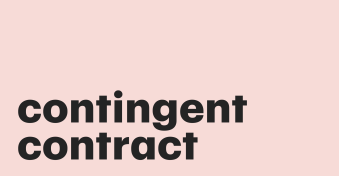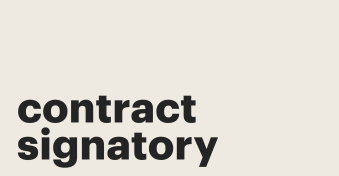When you’re looking to draft an agreement for many people to sign without making many (or any) changes to it, you’ll need a contract of adhesion.
But wait–why do businesses need these kinds of contracts, when are they used, and what are they in the first place?
We’ll be going through all the ins and outs of contracts of adhesion, so you’ll be an expert by the time you finish this article.
Stick around for pros and cons, legal details, and more.
Key takeaways
- Contracts of adhesion have their terms set up by one party, which also drafts the agreement, while the other parties simply sign them.
- You can use contracts of adhesion in a wide variety of contexts, including B2B and B2C interactions.
- They’re fully legal, meaning they’re also legally enforceable.
- Invented in France, contracts of adhesion have a relatively short history in the United States.
What is a contract of adhesion?
Sometimes also called standard form contracts, adhesion contracts, or boilerplate agreements, contracts of adhesion are a type of legal agreement that involves one party having the vast majority of the bargaining power.
In many cases, that party will have complete control over the makeup of the contract while the other merely signs.
While this answers the question ‘what is an adhesion contract?’, it doesn’t quite tell us the whole story.
That’s why we’re going to delve deeper into the contract of adhesion’s meaning by covering its origins and some practical examples.
Adhesion contracts: A brief history
These ‘take it as is’ contracts started their life in France, where they were used in the context of civil law.
They only started to be used in the US after around 1919, with a Supreme Court of California case in 1962 popularizing them further.
Throughout their relatively short history in America, the legality and uses of adhesion contracts have grown and evolved.
By now, there are more explicit rules on the kinds of elements you need to include and the language you need to use for these contracts to be legally binding.
Now, boilerplate agreements have become very common for both B2B and B2C companies.
You’ll likely have seen them when agreeing to an app’s terms of use, for example, where the customer doesn’t get to cherry-pick which parts of the contract they’re satisfied with and which they’d like to change.
Adhesion contract examples
So, what kinds of contract variations are there, and what does a contract of adhesion example look like in practice?
We’ll walk through some of the most common kinds of adhesion contracts to give you a clearer idea.
Terms and conditions
As mentioned above, when you start using a new product, you rarely get a say in the terms and conditions.
You can generally choose to agree to them and start using the product, or you can decline but lose access to the service.
Terms and conditions serve as legal protection for both the company selling the product or service and the end users. They outline appropriate, safe uses while prohibiting harmful ones.
By signing, you agree to only use the product as intended or else absolve the manufacturer of responsibility for the consequences of your actions.
Digital security measures
Any time you implement a new measure to protect yourself or your data online, you’ll find yourself on the end of a contract of adhesion.
These contracts outline the ways in which your new security product protects you and the specifics of how they can help you in the event of a data breach.
Since the contract itself represents a promise from the security provider, it can’t be edited by the recipient, just accepted or declined.
Non-disclosure agreements
An NDA, or non-disclosure agreement, prohibits one party from talking about, sharing, or publicly discussing any established confidential details.
They count as contracts of adhesion since the party creating them drafts up the entire contract and the one(s) signing have no input except to sign.
NDAs are widely useful in both B2B and B2C contexts.
You’ll often see them where new or cutting-edge projects are concerned.
Many businesses also use them to keep trade secrets and safeguard sensitive data in the case of B2B collaborations. Companies often also ask freelancers to sign NDAs.
Cease and desist notices
When you’re served a C&D notice, you don’t get to ask for adjustments in the vast, vast majority of cases.
Likewise, drawing up a cease and desist notice means you’re absolutely sure you want to legally prevent someone from continuing to say or do what they have been saying or doing.
C&D notices may be used when a business (or individual) is infringing on another’s copyright. They’re generally used as a means of protection as a result.
Liability waivers
Companies often need to ask partners and customers alike to agree to assume liability for their own actions.
This essentially means both parties agree that the company that created the waiver is legally handing over responsibility to the signing party.
Liability waivers set out the exact terms of the transfer of liability.
This makes them legally binding, as both parties can prove whether they were acting within the terms of the waiver.
Repair services
Companies that offer repair services will very often create contracts of adhesion for their customers.
These contracts explain which repairs will be carried out, what kinds of warranties (if any) the customer has a right to, and more.
They essentially set out the legal terms of the repairs that will take place, allowing for both parties to cover their backs.
Unless the contract contains a major problem or mistake, the customer generally signs without making any changes to it.
Medical, dental, or veterinary contracts
Similar to repair contracts, these kinds of medical documents are drawn up to explain what’s going to happen and what kinds of consequences and side effects the customer agrees to accept.
Medical contracts of adhesion also explain which circumstances lead to the medical professional being at fault, meaning that they serve as legal protection for the patient.
Loan documents
Banks give out loans to businesses and individuals every day, which means they need some form of standard document for these parties to sign when this happens.
That loan document needs to protect everyone involved, as well as establish the terms of its repayment and the consequences for failing to meet those terms.
In other words, they use contracts of adhesion.
People who take out loans don’t generally get to say what the terms of those loans look like–they simply sign the document the bank supplies them with.
That makes the bank the party authoring the contract of adhesion.
Master service agreements
This is a more broad, far-reaching contract that outlines the general terms of the interactions between two or more parties.
Master service agreements usually require little negotiation, so they’re often seen as a type of contract of adhesion.
Since these agreements are less on the specific side, they’ll usually be used in addition to more detailed sub-contracts.
Those would not always be contracts of adhesion since they tend to call for the involvement of more than one party in their creation.
Rental agreements
Whether it’s a vehicle, a house, or another kind of product, rental agreements are typically fully ready for renters to sign.
The owners of the product will have written out the exact terms of the rental, and the customers are expected to sign and adhere to these.
Of course, some types of rental agreements would not count as contracts of adhesion.
In this case, it depends on whether the renter has any input into the terms under which they’re borrowing or using the item in question.
The pros and cons of adhesion contracts
Like any legal document, an adhesion contract comes with its own positives and negatives.
We’ll break those down to give you a good idea of whether this is the right type of contact for your needs.
What are the benefits of using adhesion contracts?
Adhesion contracts come with the following advantages:
- You can get them out to a lot of people in little time, as one contract can be signed by many people.
- They save time since only one party has input into the final product.
- They protect one or both parties efficiently, setting out the legal terms under which anyone involved in the contract must operate.
- It’s easy to figure out what to do in the event of a breach of contract, as this is set out in the terms of the contract itself.
- They’re widespread enough that signing them is a simple, straightforward matter that is intuitive to most people, further saving time.
- They can be as complex or simple as you need them to be, covering as many or as few items as necessary. This makes contracts of adhesion highly flexible as a format.
- Since they’re legally binding, contracts of adhesion can be used in court proceedings as evidence or other supplementary material.
What are the drawbacks of adhesion contracts?
Of course, no legally enforceable document comes without its disadvantages. Those are as follows:
- Since no changes can be made to them, the parties signing them may have to put up with terms they’re not truly happy about.
- Not every situation calls for a contract of adhesion, so they’re not universally useful or applicable.
- They sometimes come with an implicit power imbalance, as one party draws them up without the input of any others.
- It can be easy to neglect to update your contracts of adhesion since the people signing them won’t be able to give you any suggestions for improvement (though you can always ask for these).
Can you enforce a contract of adhesion?
As part of your contract management, you’ll want to know when and how you can enforce any contracts you’re involved in.
It’s essential to keep tabs on whether everyone included in a contract is keeping to its terms, after all, and you need to be sure before you move ahead into threatening or enacting consequences.
Contracts of adhesion are, to put it simply, enforceable and legally binding.
This statement assumes two things.
Firstly, it relies on you, as the author of the contract, having checked for loopholes and proper language. It also assumes the person signing it has, in some proveable way, breached the contract.
If the signing party can prove that they’ve identified and exploited a loophole in your contract, you may not be able to enforce consequences.
Likewise, if you have no substantial proof that the contract was violated, you may struggle to enforce it, though you can still take the matter to court.
If both of the above conditions are met, however, then you can most certainly enforce a contract of adhesion.
Your contract itself will usually set out the consequences for anyone who breaches it, so you’ll know what to do right away too.
Fulfill all your contract needs with effective contract management software
Contracts of adhesion don’t need to be a complicated matter–provided you know exactly what you want from them and how to get it.
This means drafting your contracts carefully and always with the aid of a legal professional who knows how to properly secure the terms of the contract.
It also means using software that supports and helps you as you manage your contracts.
From better contract negotiations to easier overall contract management, dedicated software can revolutionize your approach to all manner of contracts.
That means saving yourself time, effort, and money that would otherwise go towards contract maintenance and creation.
And when it comes to contract management solutions, PandaDoc is simply one of the best ones out there.
It’s flexible, user-friendly, and useful in a wide variety of contexts.
This makes PandaDoc the ideal choice for your contracts of adhesion, whether they’re master service agreements, NDAs, or any others.
You can get started right away by creating a PandaDoc account.
Disclaimer
PandaDoc is not a law firm, or a substitute for an attorney or law firm. This page is not intended to and does not provide legal advice. Should you have legal questions on the validity of e-signatures or digital signatures and the enforceability thereof, please consult with an attorney or law firm. Use of PandaDocs services are governed by our Terms of Use and Privacy Policy.


